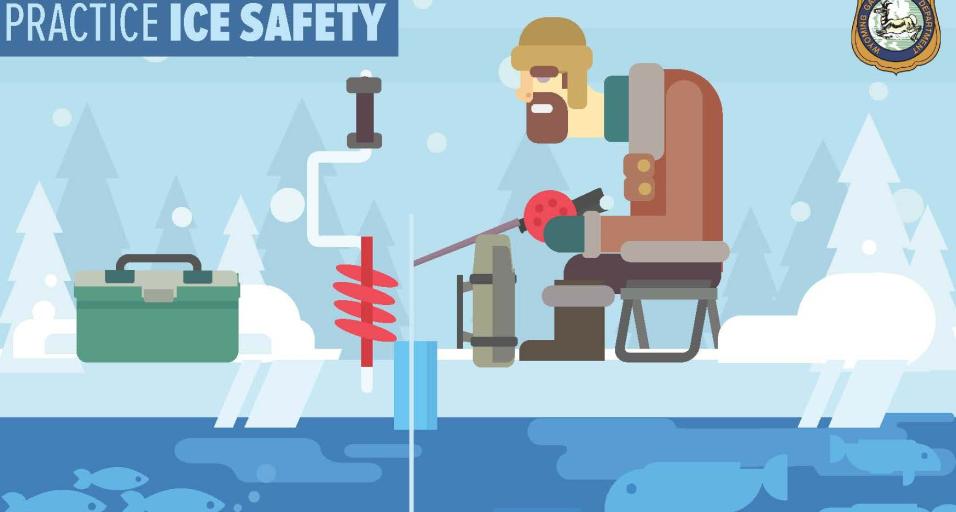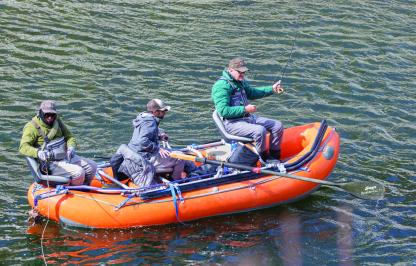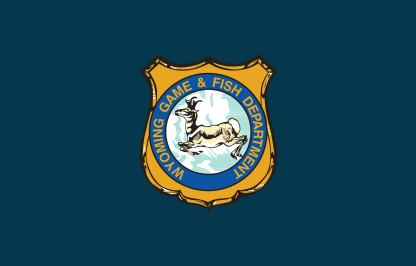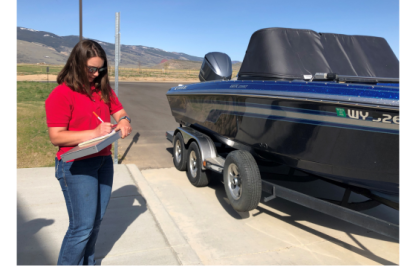Ice Fishing is on! See your local guide full of tips and answers below:
Notes from the Biologists:
The ice fishing has been good in many areas throughout the Lander Region this season and with ice newly on the waters, this is a great time to get out and fish. Fisheries biologists suggest the upper reservoir areas at Boysen as they are usually best during the beginning of the season, particularly in the Poison Creek Bay area. As ice becomes thicker and safer, more anglers will move into the main body of the reservoir.
Although the Ocean Lake and Boysen walleye populations are currently robust , some anglers are not catching many walleye. The inability for these anglers to catch walleye may be related to the time of day they fish, as most anglers fish in the late-morning and throughout the afternoon. However, walleye are most active at night, making it less likely to catch them during the middle of the day. Although ice fishing at night may not appeal to many anglers (it is colder and you can’t see well), the chances of catching walleye are better when they are more active. If night fishing does not sound like fun to you, fishing at dawn or dusk will also likely help you put a few more walleye on your stringer.
See more about fish populations in Boysen and Ocean Lake.
Ice Fishing "Attendance" FAQ's answered:
- Make sure you are in attendance of your rods/tip-ups while ice fishing (within 300 yds).
- Sleeping in the camper/truck is not attendance even if you are within 300 yds.
- Going to check in a fish during a derby does not constitute attendance of your remaining lines.
- Webster's definition of Attendance: to be present at or to be dealing with.
- When fishing with tip-ups or when fishing more than 2 lines (only on bodies of water under the special winter fishing provisions-check regulations) make sure lines or tip-ups are labeled with the name of the person fishing.
- Anglers are responsible for checking their own lines.
Ice Safety Tips:
- Never go on the ice alone.
- It is not recommended to drive a vehicle onto the ice.
- Take along plenty of warm clothes. It is also a good idea to keep extra clothes nearby.
- To walk on the ice make sure it is at least 4 inches thick and is clear and solid (8 inches if the ice is cloudy)
- It is a good idea to wear an ice pick around your neck and bring a throwable flotation device in case someone falls in.
Ice Fishing Special Provisions:
Some waters are covered under the Special Winter Ice Fishing Provision, and locally they are:
- Boysen Reservoir in Fremont County
- Ocean Lake in Fremont County
- Pathfinder Reservoir in Carbon and Natrona Counties
- Pilot Butte Reservoir in Fremont County
On waters not covered under the provision, anglers can use up to two lines.
Another special provision are bodies of water that allow live bait fish. Many people use live bait in the winter to fish through the ice because when you use live bait with tip ups the bait supplies the action. So instead of you sitting and constantly jigging the line, the live bait is doing it for you. The local waters that allow live bait fish are only the Wind River downstream from Boysen Reservoir; Boysen Reservoir; Ocean Lake; and Pilot Butte Reservoir.
Please know that you must buy live bait from a licensed dealer and they must give you a receipt you have to carry.
Complete regulations for waters under the Special Winter Ice Fishing Provision can be found under Fishing Regulations on the Game and Fish website wgfd.wyo.gov and inside the Wyoming Fishing Regulations.
Know the difference!
It is important for anglers to be able to identify sauger from their close relative walleye because of differences in creel limits. The creel limit on sauger in the Wind River drainage (including Boysen Reservoir) is two, whereas six walleye can be harvested daily or kept in possession. Sauger and walleye limits in the Wind River drainage are not combined, so an angler can possess up to eight fish as long as no more than two are sauger and no more than six are walleye. All walleye and sauger caught in the Wind River drainage also must remain whole (gills and entrails may be removed) until the angler is off the water and done fishing for the day. Once off the water and done fishing for the day, walleye and sauger may be filleted for transportation and storage. A piece of skin large enough to allow species identification (at least one (1) inch square) shall remain on all fish fillets while in transit or in the field.




